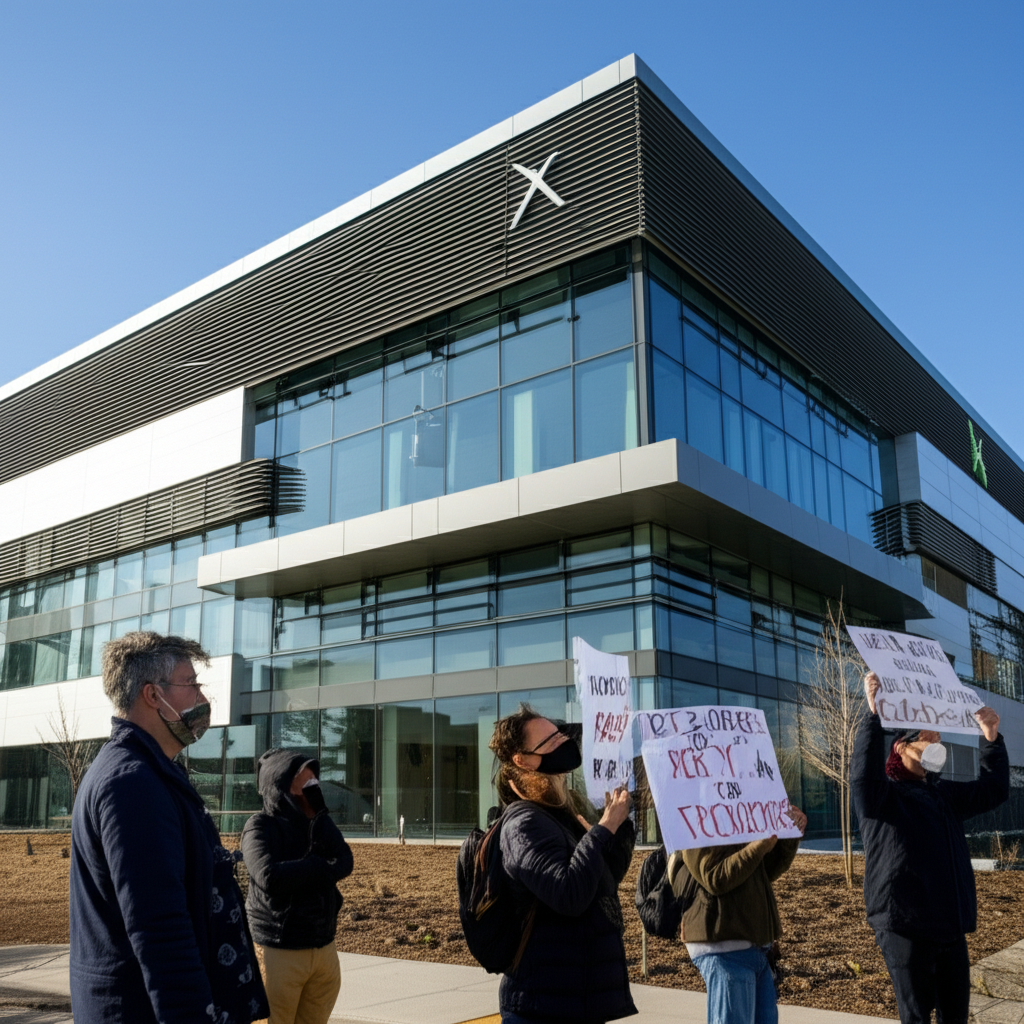Despite Protests, Elon Musk's xAI Secures Air Permit for Memphis Data Center
In a move that has ignited further controversy and solidified community resolve, the Shelby County Health Department in Memphis has granted an air permit to Elon Musk’s xAI data center. The permit allows the facility to continue operating the gas turbines essential for powering the company’s ambitious AI projects, including the Grok chatbot. This decision arrives amidst widespread community opposition and the backdrop of a pending lawsuit alleging significant violations of the Clean Air Act.
The local health department released the official air permit for the xAI project on a Wednesday, following a period that saw hundreds of public comments submitted, largely in opposition to the project’s environmental impact. The news was initially reported by the Daily Memphian, highlighting the local significance of the regulatory body's decision.
The story of xAI's presence in Memphis began in June when the Memphis Chamber of Commerce announced the city had been chosen as the site for the company's new supercomputer facility. xAI’s public statements boast of the remarkable speed with which they constructed this supercomputer, dubbed Colossus, claiming it took just 122 days. This rapid deployment was facilitated, in part, by the swift installation of mobile gas turbines at the campus, located on the site of a former manufacturing facility. Colossus, reportedly built using 100,000 Nvidia H100 GPUs, is positioned as one of the world's largest supercomputers, designed to help xAI compete with leading AI labs like OpenAI, Google, and Anthropic.
A Community Under Burden: Boxtown's Struggle
The chosen location for xAI's Memphis campus is the community of Boxtown, a predominantly Black neighborhood that has historically borne a disproportionate burden of industrial projects and their associated pollution. This history of environmental injustice adds a critical layer to the current controversy surrounding xAI's operations.
Gas turbines, like those employed by xAI, are known sources of harmful emissions, particularly nitrogen oxides (NOx). NOx contributes significantly to the formation of smog, a major air quality issue. The potential increase in such pollutants is a grave concern for Boxtown residents and the wider Memphis area, which already faces significant public health challenges. Memphis, specifically Shelby County, has some of the highest rates of child asthma in Tennessee, a condition that can be exacerbated by air pollution. Since xAI began running its turbines, residents have actively organized, holding meetings and rallies to voice their opposition and concerns about the project's impact on their health and environment.
KeShaun Pearson, a leader of Memphis Community Against Pollution, expressed profound disappointment and anger following the permit approval. “I am horrified but not surprised,” Pearson stated. “The flagrant violation of the Clean Air Act and the disregard for our human right to clean air, by xAI’s burning of illegal methane turbines, has been stamped as permissible by the Shelby County Health Department. Over 1,000 people submitted public comments demanding protection and got passed over for a billionaire’s ambitious experiment.”
The Regulatory Maze and Alleged Violations
Under the Clean Air Act, facilities classified as “major” sources of emissions, such as a cluster of large gas turbines, typically require a specific type of permit known as a Prevention of Significant Deterioration (PSD) permit before construction or modification begins. This permitting process is designed to ensure that new or modified sources of pollution do not significantly worsen air quality, particularly in areas that already meet federal air quality standards.
Initially, Shelby County Health Department officials reportedly indicated that a PSD permit was not necessary for xAI's turbines, characterizing them as temporary. This stance drew criticism, as the turbines were installed and began operating months before any formal permit application was submitted. Amidst escalating local opposition and scrutiny, xAI eventually applied for a permit with the Shelby County Health Department in January, well after the turbines were already running.
The delay in seeking a permit and the operation of the turbines during this period form the basis of a significant legal challenge. Last month, the NAACP and the Southern Environmental Law Center (SELC) announced their intention to file a lawsuit against xAI, alleging violations of the Clean Air Act. Their notice of intent to sue highlighted concerns that xAI had been operating a major source of air pollution without the required permits.
Amanda Garcia, a senior attorney at SELC, criticized the health department's decision to grant the permit. “The decision to give xAI an air permit for its polluting gas turbines flies in the face of the hundreds of Memphians who spoke out against the company’s permit request,” Garcia said in a press release. “Instead of confronting long-standing air pollution problems in South Memphis, the Shelby County Health Department is turning a blind eye to obvious Clean Air Act violations in order to allow another polluter to set up shop in this already-overburdened community without appropriate protections.”
Discrepancies and Visual Evidence
Adding to the complexity and controversy are discrepancies regarding the number of gas turbines operating at the xAI site. The new permit from the health department authorizes the company to operate 15 turbines until 2027. However, reports and observations suggest a higher number of turbines have been in operation.
In June, Memphis mayor Paul Young wrote an op-ed stating that xAI was currently operating 21 turbines. Furthermore, the SELC reported that aerial footage it captured in April appeared to show as many as 35 turbines operating at the facility. This disparity between the permitted number, reported number, and observed number of turbines raises questions about the scope of operations and the adequacy of the permitting process.
Visual evidence has also played a role in highlighting potential environmental issues. In May, Sharon Wilson, a certified optical gas imaging thermographer known for tracking emissions in oil and gas regions, traveled to Memphis to film emissions from the xAI site. Using a specialized camera capable of making usually invisible gas emissions visible, Wilson documented what she described as one of the densest clouds of emissions she had ever seen. “I expected to see the typical power plant type of pollution that I see,” she stated. “What I saw was way worse than what I expected.” This visual documentation provides a compelling, albeit qualitative, indication of the pollution emanating from the site.

The Broader Context: AI's Growing Energy Footprint
The situation in Memphis is a microcosm of a larger, emerging challenge: the immense and rapidly growing energy demands of artificial intelligence and the data centers that power it. Training and running large language models and other sophisticated AI systems require vast amounts of electricity, often generated by sources that contribute to air pollution and climate change.
Data centers globally are consuming increasing percentages of the world's energy supply. While the tech industry is exploring renewable energy sources, the speed of AI development often outpaces the deployment of clean energy infrastructure. This leads companies to rely on existing grids, which may be powered by fossil fuels, or, as in xAI's case, deploy on-site power generation like gas turbines for speed and flexibility. This reliance on energy sources with significant environmental footprints raises critical questions about the sustainability of the AI boom.
The choice of location for data centers also intersects with issues of environmental justice. Historically, industrial facilities, including power plants and manufacturing sites, have been disproportionately located in low-income communities and communities of color. These communities often already face higher levels of pollution and associated health risks. Placing energy-intensive data centers with on-site fossil fuel generation in such areas can exacerbate existing environmental burdens, perpetuating a cycle of injustice.
The protests in Boxtown reflect a growing awareness and activism within these communities, demanding that new developments, even those framed as technologically advanced and economically beneficial, do not come at the cost of residents' health and environmental quality. The community's call for protection, supported by environmental law organizations, underscores the need for equitable distribution of environmental benefits and burdens.
Legal Battles and Community Appeals
Following the health department's decision to grant the permit, the Southern Environmental Law Center stated it was “evaluating [its] options,” suggesting the lawsuit against xAI remains a strong possibility. Community leaders like KeShaun Pearson have made it clear that they are not backing down. “The people are awake and ready to fight back,” Pearson told WIRED. “You can expect to see an appeal!”
The legal challenge is likely to focus on whether xAI violated the Clean Air Act by operating the turbines without a proper permit for an extended period and whether the granted permit adequately addresses the potential emissions and their impact on the surrounding community, particularly given the area's existing environmental challenges and health vulnerabilities.
The Clean Air Act includes provisions for citizen suits, allowing individuals and groups to sue entities alleged to be in violation of the act's requirements. This mechanism provides a pathway for communities like Boxtown to seek accountability and enforce environmental regulations when they believe regulatory bodies are not adequately protecting them.
Beyond the lawsuit, community members may also pursue administrative appeals of the permit decision itself, challenging the health department's finding that the permit is sufficient or that xAI's operations meet regulatory standards. Such appeals processes can be lengthy but offer another avenue for community voices to be heard and for the permit's legal basis to be scrutinized.
The Future of AI Infrastructure and Environmental Responsibility
The conflict in Memphis serves as a critical case study at the intersection of rapid technological advancement, energy infrastructure, environmental regulation, and social equity. As the demand for AI capabilities continues to surge, the need for massive data centers will only grow. How these facilities are powered and where they are located will have significant implications for local environments and communities.
The industry faces increasing pressure to adopt more sustainable practices, including sourcing renewable energy, improving energy efficiency, and considering the environmental and social context of potential sites. While the speed of deployment is a competitive advantage in the AI race, the situation in Memphis highlights the potential costs when environmental due diligence and community concerns are perceived as secondary.
Regulatory bodies also face the challenge of adapting to the unique characteristics of AI infrastructure, such as the potential for rapid deployment and high-density energy consumption. Ensuring that existing environmental laws, like the Clean Air Act, are effectively applied and enforced in the context of these new technologies is crucial for protecting public health and the environment.
The outcome of the potential lawsuit and any appeals regarding xAI's permit in Memphis will likely set precedents for how future AI data center projects are evaluated and regulated, particularly in communities already burdened by pollution. It underscores the growing demand for environmental justice to be a central consideration in technology development and infrastructure planning.
Conclusion
The decision by the Shelby County Health Department to grant an air permit to xAI's Memphis data center, despite significant community opposition and allegations of prior Clean Air Act violations, marks a pivotal moment in this ongoing dispute. For the residents of Boxtown and environmental advocates, it represents a failure of regulatory protection and a continuation of environmental injustice.
While xAI gains official approval to operate its gas turbines under the terms of the permit, the fight is far from over. The looming lawsuit from the NAACP and SELC, coupled with the community's stated intention to appeal the permit decision, indicates that legal and public challenges will continue. The case in Memphis highlights the critical need for transparency, robust environmental review, and meaningful community engagement as the world builds the infrastructure necessary to power the future of artificial intelligence. It serves as a stark reminder that the pursuit of technological advancement must be balanced with the fundamental right to clean air and a healthy environment for all communities.
External Links:
